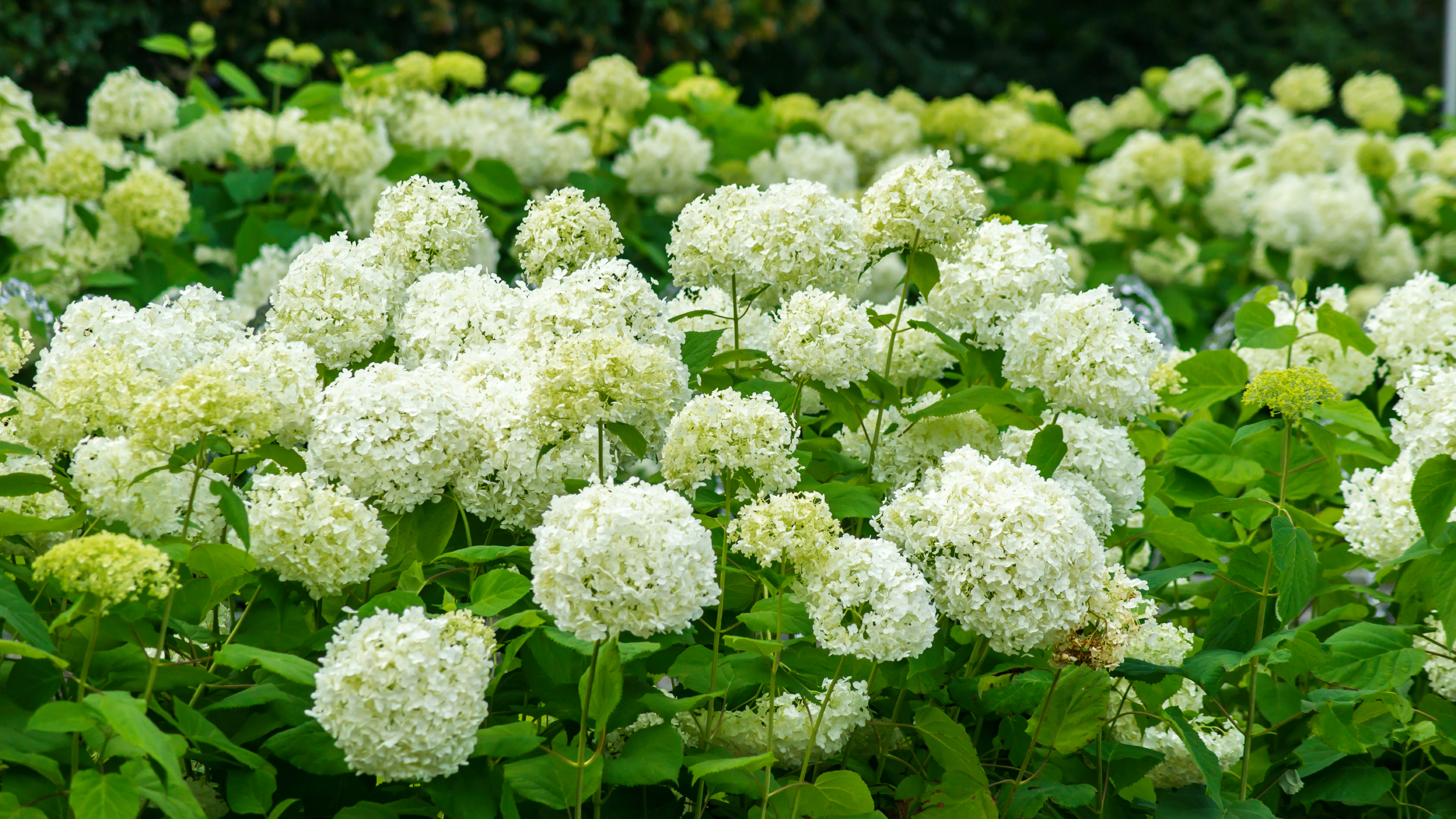Hydrangea Arborescens Is The Elegant Native Shrub That Deserves A Spot In Every Garden – How To Grow This Summer Stunner
Hydrangea arborescens, a native variety with snowball-like blooms, makes a wonderful addition to any garden. Learn how to grow this shrub in your landscape.


Quick Facts
Botanical name: Hydrangea arborescens
Height: 3-5 feet (1-1.5 m)
Spread: 3-5 feet (1-1.5 m)
Sun exposure: Part Sun
Soil requirements: Neutral to acidic, well-drained, fertile
Hardiness zones: USDA 3 to 9
When to plant: Spring
Bloom time: Summer
The smooth hydrangea (Hydrangea arborescens) is a flowering, deciduous shrub that is native to the Eastern and Central United States. Also called the snowball hydrangea or wild hydrangea, it makes a wonderful wildlife-friendly addition to any mixed border, woodland garden, native landscape, or rain garden.
Smooth hydrangea is hardy in USDA zones 3 to 9 and can tolerate a wide range of soil conditions. This gorgeous native hydrangea variety flowers from June until first frost, providing months of elegant white blossoms.
This easy-to-grow hydrangea variety is a great starter shrub for new gardeners to try, since it blooms profusely with little effort. It also has almost no pruning needs, which is one of the biggest hydrangea care mistakes beginner gardeners make. Let’s take a look at what you need to know to grow a gorgeous Hydrangea arborescens in your yard or garden.
What Is a Smooth Hydrangea?
This common type of hydrangea forms a low mound of heart-shaped green leaves and sturdy stems that turn yellow in the fall. The plant foliage has a coarse texture, and grows to about 3 to 4 feet (1 m) tall with an even wider spread by the time fall comes.
This wild hydrangea variety blooms in summer and has two different flower forms. One is similar to a lacecap hydrangea—a flat head with tiny, creamy-white fertile flowers surrounded by a few larger, white flowers. Small, brown seed capsules replace the flowers as they ripen in fall.
The more common variety of Hydrangea arborescens is similar to a mophead hydrangea—it has ball-shaped flowers in pink or white. When the flowers open, they are slightly green. The color changes to creamy white as they mature and then to brown as they fade. They’re a classic white hydrangea variety that adds easy elegance to landscapes.

Smooth Hydrangea Care
Hydrangea arborescens is a low-maintenance delight. This native shrub is easy to grow and adds simple elegance to any home landscape. Here are the basics for growing this beautiful bush.
Sign up for the Gardening Know How newsletter today and receive a free copy of our e-book "How to Grow Delicious Tomatoes".
Light
Smooth hydrangea care starts by selecting an appropriate planting location. These native shrubs grow best in part shade. In fact, they’re one of the best hydrangeas for shade.
The further north you grow smooth hydrangeas, the more sun they can tolerate. But in the south, they need more shade. Ideally, choose a location that gets sun in the morning, but has some shade during the heat of the afternoon.

Water
Provide Hydrangea arborescens with moderate water, especially after first planting. Once smooth hydrangeas are established, water them occasionally if the weather is very dry. The leaves will deteriorate in drought. If planted in full sun, your hydrangea will need more consistent watering.
Hydrangeas require water when the soil two inches (15 cm) below ground is dry or when the leaves begin to droop. Smooth hydrangeas prefer a moist soil, so supplemental water is needed when rainfall is not consistent.
Temperature & Humidity
In warmer southern regions, grow smooth hydrangeas in areas with afternoon shade to balance out the heat of the day. In cooler northern regions, hydrangeas can tolerate more sun.
Soil
Smooth hydrangeas grow best in rich, well-draining soils that have an acidic or neutral pH. Hydrangea arborescens may become chlorotic in very alkaline soils. Unlike with other varieties, you can’t change hydrangea color by altering the soil pH.
Smooth hydrangeas can tolerate a variety of soil conditions, even unfavorable ones. They don’t mind clay soil and can even grow these plants near black walnut trees, which release toxic juglone into the soil and stunt many plants’ ability to grow.

Fertilizer
Before planting your smooth hydrangea, work in a few inches (8 cm) of organic compost to enrich the soil. Once they’re established, fertilizing hydrangeas isn’t necessary. If your hydrangea is not blooming or your shrub looks a bit lacking, feed with a balanced fertilizer such as 10-10-10 in early spring.
Problems, Pests & Diseases
Hydrangea arborescens can be vulnerable to pests such as aphids, scale, and mites, which can be treated with Neem oil. Diseases such as bud blight, leaf spot, powdery mildew, and rust can be a problem. Smooth hydrangeas may also sucker underground and form colonies.
Be careful if you have pets that go outside, all parts of Hydrangea arborescens are toxic to dogs, cats, and horses if ingested. Deer and rabbits tend to leave it alone.

Pruning
Hydrangea arborescens grows on long canes with little branching, so pruning is not often necessary. While pruning hydrangeas isn’t required for this variety to bloom, you can always remove any broken or diseased canes. Remove unwanted suckers at any time as well.
Shrubs sometimes die back in winter, but quickly regrow in spring. Since these hydrangeas bloom on new wood, you can cut them back hard while they’re still dormant to control their size or rejuvenate them.
To rejuvenate a smooth hydrangea, prune the shrub down to 6 inches (15 cm) in late winter to early spring. As an alternative, you can remove one third of the oldest canes in late winter over the course of three years until the entire shrub is renewed.
Propagation
To grow more plants, you can propagate this plant by growing seeds or by stem cuttings. Seeds grown from a cultivar will not produce the same plant as the parent. To grow an identical plant, choose stem cuttings. The wild form, however, should come true from seed.
Wildlife Benefits
Hydrangea arborescens is a fantastic foundation plant for any native plant garden or pollinator garden. This shrub produces nectar and pollen for butterflies, moths, and pollinators and is the host plant for the hydrangea sphinx moth caterpillar. Birds also eat the seeds, which persist into winter.

Varieties
- ‘Annabelle’ A popular cultivar with large, rounded, white flower clusters held on upright stems. The longtime-loved Annabelle hydrangea is available now in the Gardening Know How Shop.
- ‘Haas Halo’ Large, white flower heads in lacecap style bloom on woody shrubs growing 4 to 6 feet (1.2 to 1.8 m) tall. Prefers more sun than the wild form. You can get the hard-to-find Haas Halo from the Gardening Know How Shop.
- ‘Incrediball Blush’ Large pink flower heads bloom on a woody shrub growing 4 to 5 feet (1.2 to 1.5 m) tall. The classic white version, ‘Incrediball’ is available in the Gardening Know How Shop.
- ‘Invincibelle Ruby’ 12-inch (30 cm) wide mophead blooms are a combination of ruby red and silvery pink. Flowers last from summer to fall on 3 to 4 foot (0.9 to 1.2 m) woody shrubs. The new and improved 'Invincibelle Spirit II' is now available in the Gardening Know How Shop.
Frequently Asked Questions
Where can I buy smooth hydrangeas?
The Gardening Know How Shop is a great source for smooth hydrangeas and tons of other native plants. Explore dozens of expert-approved hydrangea varieties in the online shop as well.
When should I prune a smooth hydrangea?
Smooth hydrangea blooms on new growth so it is safe to prune in late winter or early spring, if needed.
This article features products available from third party vendors on the Gardening Know How Shop. Keep in mind that our plant inventory is limited—so if you’re thinking of purchasing, don’t wait!

After graduating from Oklahoma State University with a degree in English, Susan pursued a career in communications. In addition, she wrote garden articles for magazines and authored a newspaper gardening column for many years. She contributed South-Central regional gardening columns for four years to Lowes.com. While living in Oklahoma, she served as a master gardener for 17 years.
- Laura WaltersContent Editor
- Teo SpenglerWriter
